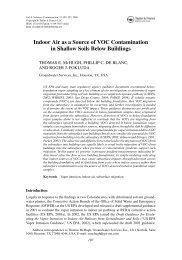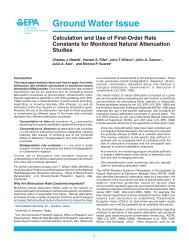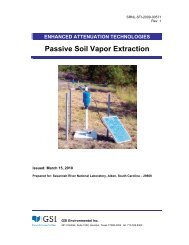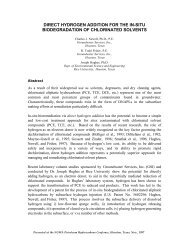Parameter Estimation Guidelines for Risk-Based Corrective Action ...
Parameter Estimation Guidelines for Risk-Based Corrective Action ...
Parameter Estimation Guidelines for Risk-Based Corrective Action ...
You also want an ePaper? Increase the reach of your titles
YUMPU automatically turns print PDFs into web optimized ePapers that Google loves.
Groundwater Services, Inc.<br />
occur at the point of exposure (POE) are calculated using the steady-state analytical fate-andtransport<br />
models identified in Appendix X.2 of ASTM E-1739. To per<strong>for</strong>m these calculations,<br />
the system evaluates cross-media partitioning (e.g., volatilization from soil to air) and lateral<br />
transport from the source to the POE (e.g., contaminant transport via air or groundwater flow).<br />
The source media and optional exposure pathways included in the software as as follows:<br />
SOURCE MEDIA<br />
Surface Soils<br />
Subsurface Soils<br />
Groundwater<br />
EXPOSURE PATHWAYS<br />
• Inhalation of Volatiles and Particulates<br />
• Dermal Contact with Soil<br />
• Ingestion of Soil and Dust<br />
• Leaching to Groundwater/Ingestion<br />
• Inhalation of Volatiles<br />
• Leaching to Groundwater/Ingestion<br />
• Ingestion of Potable Water<br />
• Inhalation of Volatiles<br />
• Average Daily Intake: <strong>Based</strong> upon the exposure factors selected by the user, the average daily<br />
chemical intake <strong>for</strong> each receptor along each selected pathway is calculated in accordance with<br />
EPA guidelines (see Connor et al, 1995). These values are used in baseline risk calculations <strong>for</strong><br />
each complete pathway.<br />
• Baseline <strong>Risk</strong> Characterization: Human health risks associated with exposure to COCs are<br />
calculated by the spreadsheet on the basis of average daily intake rates and the corresponding<br />
toxicological parameters <strong>for</strong> carcinogenic and non-carcinogenic effects. For each complete<br />
pathway, the system output provides both individual and additive constituent results <strong>for</strong><br />
carcinogens and non-carcinogens.<br />
• Media Cleanup Values: The RBCA Spreadsheet System has the ability to i) compare site data to<br />
Tier 1 <strong>Risk</strong>-<strong>Based</strong> Screening Levels (RBSLs), computed using default parameter values as listed in<br />
ASTM E-1739, or ii) calculate Tier 2 Site-Specific Target Levels (SSTLs) based on user-supplied<br />
site characterization in<strong>for</strong>mation. For each source medium (i.e., affected soil and groundwater),<br />
the software reports target concentrations <strong>for</strong> all complete pathways and identifies the applicable<br />
(i.e., minimum) value <strong>for</strong> source remediation.<br />
Fate and Transport Modeling Methods<br />
The RBCA Spreadsheet System contains a series of fate and transport models <strong>for</strong> predicting COC<br />
concentrations at the point of exposure (POE) <strong>for</strong> each of the optional exposure pathways listed<br />
above. Under Tier 2 of the RBCA process, relatively simple analytical models are to be employed<br />
<strong>for</strong> this calculation, representing a minor incremental ef<strong>for</strong>t relative to Tier 1. The spreadsheet<br />
modeling system is consistent with Appendix X.2 of ASTM E-1739, although selected algorithms<br />
and default parameters have been updated to reflect advances in evaluation methods.<br />
The idealized schematic shown on Figure 1 illustrates the steps <strong>for</strong> predicting transport of<br />
contaminants from the source zone to the POE <strong>for</strong> air and groundwater exposure pathways. Each<br />
element in Figure 1 represents a step-specific attenuation factor, corresponding to either a crossmedia<br />
transfer factor (CM) or a lateral transport factor (LT). The effective natural attenuation factor<br />
(NAF) <strong>for</strong> each COC on each pathway is then calculated as the arithmetic product of the various<br />
attenuation factors occurring along the flow path from source to receptor. These steady-state NAF<br />
values are then used <strong>for</strong> calculation of baseline risks and back-calculation of Site-Specific Target<br />
Levels (SSTLs), as discussed above. Please note that fate and transport modeling is not required<br />
<strong>for</strong> exposure via direct contact with the source medium, such as soil ingestion or dermal contact,<br />
NGWA Petroleum Hydrocarbons Conference 2 <strong>Parameter</strong> <strong>Estimation</strong> <strong>Guidelines</strong><br />
Houston, Texas, November 1996<br />
<strong>for</strong> RBCA Modeling






